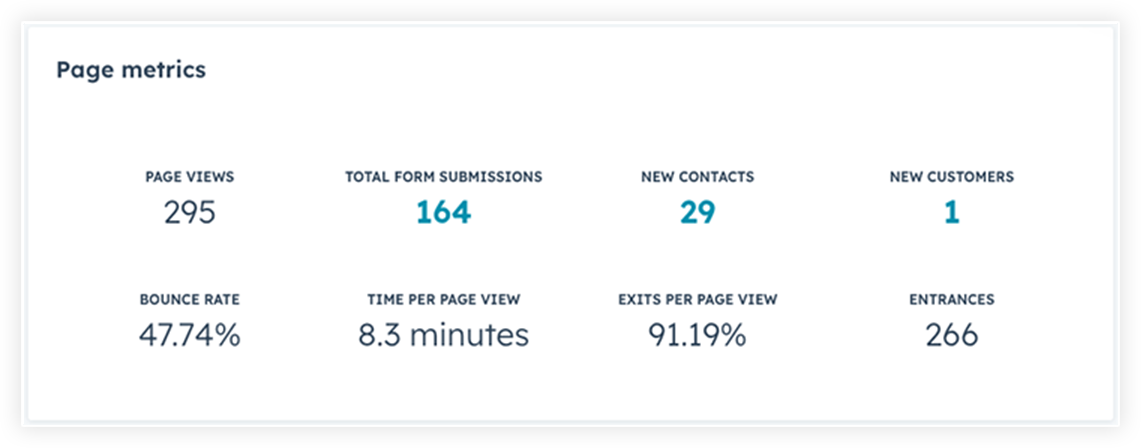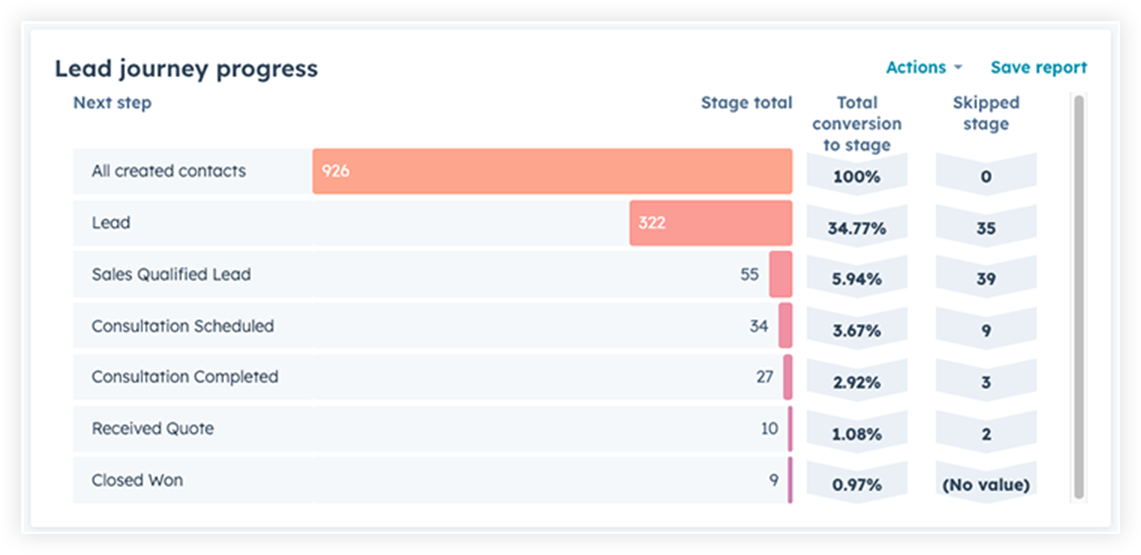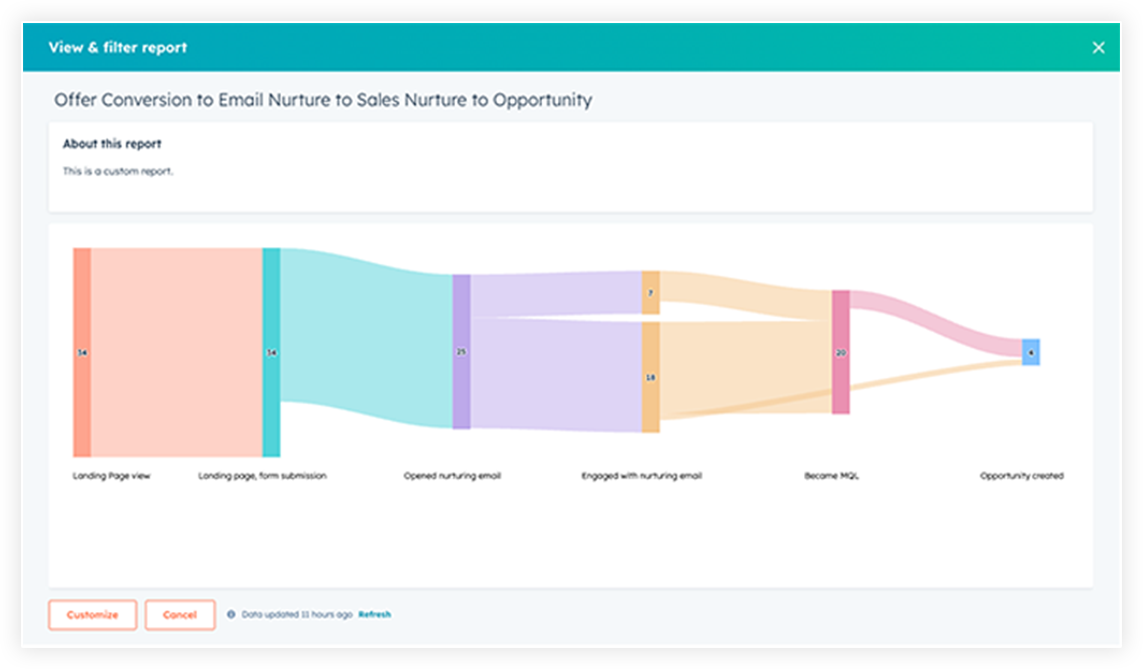Does your marketing team send the same generic emails to everyone, regardless of whether they're new prospects, or qualified leads? Are you constantly updating data manually, unsure if your sales reports truly reflect where leads stand? These are some classic symptoms of teams who haven’t adopted lifecycle stages.
HubSpot's lifecycle stages offer a structured way to track a lead's journey from their very first interaction with your company to being loyal customer, improving your engagement and conversion efforts. This simple feature, which is a drop-down property on contact and company records, gives you more precise reporting and improves decision-making.
If you haven’t been taking advantage of HubSpot lifecycle stages, you may be wasting a lot of time and effort on inefficient methods, or worse, you’re flying in the dark when it comes to lead management.
Some of the most common mistakes we see fall in these three camps:
-
You’re managing a custom property you created to track your own version of lifecycle stages
-
You’re using the deals pipeline incorrectly, with stages that represent things far too early in the process that would be better managed by lifecycle stages
-
You’re not doing anything to track this info, leaving you with little to no idea how effectively you’re creating and converting qualified leads
Let’s take a look at some of the high-level reasons why you shouldn’t ignore this feature, and then we’ll show you some of the use cases that our clients tend to find the most helpful.
Looking for the basics? We also wrote an in-depth explanation of what HubSpot lifecycle stages are and how they work, which includes some best practices to get started. You can also check out the lifecycle stages video guide from HubSpot Hacks, the YouTube channel produced by Simple Strat.
Why you should be using HubSpot lifecycle stages
You can sort your contacts into the right stages, without the headache
Lifecycle stages offer a straightforward method to organize the contacts and companies in your CRM based on where they’re at in the buyer journey.
By identifying where each prospect is in their buying journey, you can tailor your communication to meet their precise needs more effectively. This way, you can make sure you're talking to them the right way at the right time, so your communications are more effective.
You can better rely on provided training resources
A big advantage of using lifecycle stages is that you can get more value from the broad range of training materials available to you, particularly from HubSpot Academy. These resources make frequent references to lifecycle stages since their so integral to the HubSpot platform. When you’re using them correctly, your use of the HubSpot platform will be strongly aligned with these training resources, making it much easier to leverage them in the future when onboarding new employees to HubSpot.
You get to minimize manual data entry
One of the best things about lifecycle stages? They can be almost entirely automated through HubSpot settings and workflows. For example, people that register can automatically be marked as a lead when they submit the registration form, advanced to the marketing qualified lead stage when they reach a certain lead score, marked as an opportunity once a deal is created, etc.
That means less time spent on tedious tasks and more time for you to focus on growing your business. It's all about making your life easier and keeping your records spot-on with minimal fuss.
You’ll have improved reporting clarity and accuracy
Using lifecycle stages helps you sort and understand your leads better, making it easier to see how well your marketing and sales strategies are working. It keeps everyone on the same page by using the same rules to track leads, reducing mistakes and confusion.
Plus, HubSpot automatically provides helpful data based on how records advance through your lifecycle stages. The platform automatically date stamps when records enter a stage and the time they spend in each stage.
All this information allows you to easily create reports that show how many records enter stages in a given time period, how effectively you convert buyers to the next stage (conversion rates), and how quickly you move buyers through your marketing and sales funnel. You can also drill down to see this data segmented by campaign, channel, demographics, and more.
The best ways to take advantage of HubSpot lifecycle stages
Let’s dig a little deeper into some of the tactical approaches to using HubSpot lifecycle stages, letting you take better advantage of what HubSpot has to offer.
Pro tip: While you can create your own custom lifecycle stages, we generally advise our clients to use the default, HubSpot-provided stages as much as possible and limiting edits. The provided stages are standard across industries and company sizes, so using them is helpful when bringing in new employees or sharing data with stakeholders like boards or investors.
Automate lifecycle stage updates for hassle-free organization
HubSpot offers several automated ways to ensure your lifecycle stages accurately reflect your contacts' and companies' progress. It lets you:
-
Set a default lifecycle stage to newly created records: Instantly categorize new contacts or companies for streamlined organization.
-
Link forms to lifecycle stages: Automatically place contacts entering through specific forms into the appropriate stage.
-
Sync with HubSpot's Leads object (Sales Pro & Enterprise): Seamlessly create leads at a designated stage or update contact/company lifecycle stages when a new lead is generated.
-
Sync with HubSpot's Deals object: Effortlessly update the lifecycle stages of contacts or companies associated with new or closed-won deals.
-
Leverage workflows for customization (Pro & Enterprise): As with any other property, you have the flexibility to update lifecycle stages based on tailored actions and triggers within your workflows.
Use your lifecycle stages for powerful reporting insights
Track progress with automated timestamps: HubSpot records exact dates for when contacts/companies enter and exit each lifecycle stage, as well as how long they remain in each (Pro & Enterprise).
Get immediate value from built-in reports: Instantly leverage pre-made reports using lifecycle stage data. This is especially beneficial for organizations that are on HubSpot’s Starter level and don’t have access to the custom report builder.

Understand asset performance: HubSpot's "new customers" metric is tied to the "customer" lifecycle stage, and lets you measure success across ads, landing pages, blog posts, and web pages.

Visualize the full sales funnel: Combine lifecycle stages with lead and deal stages to gain a comprehensive view of your lead journey. (Sales Professional & Enterprise)

Analyze customer journeys: Lifecycle stage changes can be used in Customer Journey Reports, letting you uncover critical insights and optimize customer experiences. (Marketing Enterprise)

Optimize ad campaigns with lifecycle stage conversion tracking
Use lifecycle stages as conversion events in your digital ad campaigns (Marketing Professional or Enterprise). This allows you to optimize ad campaigns to drive actual conversions rather than just clicks.
This powerful feature works with Google Ads, Facebook Ads, and LinkedIn Ads (the article linked here discusses Google Ads currently, but this works for all three).
Improve email campaign targeting
Effortlessly segment your contacts using lifecycle stages to distinguish customers from prospects. This allows you to craft highly relevant email newsletters and campaigns, boosting engagement and driving better results.
Increase personalization for emails and more with smart content
Provide more personalized messages and content by using lifecycle stages: show offers, announcements, or language tailored to whether contacts are leads, customers, or at other points in their journey. By tailoring content and CTAs to each stage, you’re providing a more relevant and helpful experience, helping improve engagement and conversion rates. This is available for certain modules across emails, blog posts, pages, and templates.
Don’t forget to have a clear plan
As with many aspects of HubSpot, if you don’t set this all up without a clear plan, you’ll likely need to hire help later. Improperly set up lifecycle stages can create a lot of confusion and wasted time. This often leads to missed opportunities, duplicated efforts, and misalignment between marketing and sales efforts.
But lifecycle stages aren’t the only thing commonly misunderstood by HubSpot users. If your HubSpot setup seems more complicated than it needs to be (or feels outright broken), you may want to take a look at our "Fix my HubSpot" services. We’ll take care of whatever’s broken and make it easy to keep things clean and efficient moving forward, giving you the guidance to use HubSpot with confidence.


